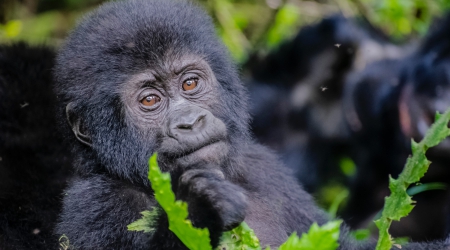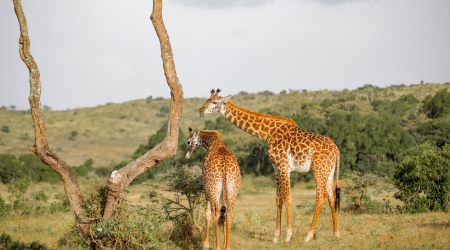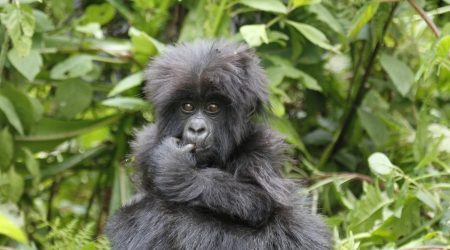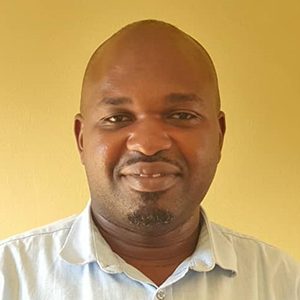There are more than 1060 mountain gorillas left in the world and half of the remaining mountain gorillas live in Uganda protected in two National parks; Bwindi impenetrable forest national park and Mgahinga national parks located at the edge of the Albertine rift valley in remote areas of southwestern Uganda. The ancient tropical forest of Bwindi occupies about 321 sq km and host about 480 mountain gorillas which puts Bwindi impenetrable Forest National Park at the top of other gorilla destinations if you want to see gorillas in their natural wilderness.
There are currently 18 family groups of gorillas that have been habituated for tracking in Uganda of which 16 of these are found in Bwindi Impenetrable National park alone while the other one group is in the nearby Mgahinga National park which form part of Virunga Mountain Ranges bordering Rwanda and DR Congo.
Besides the 18 habituated gorilla groups for gorilla tracking, there are other two more habituated for gorilla habituation experience where tourists will stay with the gorillas for four hours contrary to the maximum one hour allowed to stay with the gorillas on gorilla tracking adventure.
Bwindi impenetrable national park is divided in four sectors; Buhoma sector with three habituated families, Ruhija sector with 3 gorilla families, Rushaga sector with seven families and Nkuringo sector with 2 habituated gorilla family.
Can I see the gorillas?
It is possible to get close to rare mountain gorillas provided you have booked your gorilla permit which you should obtain in advance by contacting Uganda wildlife Authority or local tour operators in Uganda.
The gorillas are habituated for human interaction and will not pose any danger. With the guidance of the park rangers and guides, you will be able to penetrate the forest in search of these gentle giants, an exercise that will take 1-7 hours depending on their movement in their natural wild.
What else do you see besides the gorillas?
Besides gorillas, Bwindi impenetrable national park is rich in diversity of species of flora and fauna; it shelters 120 mammals, 350 species of birds, 220 butterfly species, more than 400 plants and several reptiles and amphibians.
On the other hand Mgahinga national park lies at high altitude volcanic mountains between 2,227 – 4,127 meters above sea level with a great diversity of wildlife and tourism activities like hiking, cultural tours to the Batwa, birding. There are mammals like forest buffalo, elephants, worth hogs, Albertine rift endemic birds as well as gorillas and the critically endangered golden monkeys which will be seen.
How do you get there?
Bwindi impenetrable Forest and Mgahinga National park can be accessed by road from Kampala or from Kigali Rwanda. The road journey from Kampala to Bwindi NP or Mgahinga national park takes 10 hours drive largely on a tarmac road, with a small section towards the national park not tarmacked.
Then, the road trip from Kigali takes 4 hours on a paved road. The parks can also be accessed by flight from Entebbe to Kisoro airstrip for Mgahinga National park and Bwindi impenetrable Forest national park as well as flight to Kihiihi airstrip.
What do I need to see the gorillas?
Gorilla tracking is a way of conserving the mountain gorillas by contributing some money towards seeing the gorillas. Therefore, to be able to collect this money, there is a gorilla tracking permit that is sold by Uganda wildlife Authority.
A gorilla permit costs USD700 for foreign non resident, USD600 for East African Resident, 250000 UGX for East African Citizens.
Gorilla trekking permits can be purchased from Uganda Wildlife Authority or tour operators. Permits should be booked for in advance of 2-3 months because permits tend to get finished due to competition. Visitors should inquire about booking for specific families of gorillas to suit their level of fitness.
Ready to trek and see gorillas in the mist covered forests
The cool winds sweeping across the forest roaring like a storm and friendly locals will welcome you. Then have your overnight in home like lodge, camp or hotel for relaxation. You are advised to book and stay in accommodation near the trekking points because treks commence very in the morning at 7:00 am. The Uganda Wildlife Authority guide will take you through a briefing about the rules and regulations of seeing gorillas in their natural habitat.
Note, gorilla trekking is limited to 8 people who can see gorillas for one hour, eco tourism is a way of conserving gorillas and their habitats by regulating human contact. Remember gorillas have 95% of their DNA similar to that of humans hence very prone to contract human infectious gorillas such as human colds and coughs.
Rules to see gorillas are very strict and must never be compromised whatsoever. While with gorillas, a distance of 7 meters must be kept, sick visitors cannot be allowed to see gorillas, whenever you feel like coughing or sneezing, you must turn your head away from gorillas. Visitors are free to ask a guide about anything, all human waste must be buried 30 centimeters deep underground. Eating, smoking in front of gorillas is prohibited.
What to wear and expect a Gorilla Trek?
Before you make your way into the forest, Visitors should be dressed and equipped in a full hiking gear which you must have obtained in advance to prepare for the muddy, slippery and steep slopes, tangled vegetation and wet conditions in a rain-forest. Long pants, solid hiking boots, warm under wears, long sleeved shirts, rain courts, gloves to grip vegetation, hut, and insect repellents are recommended.
The guide will just tell you to pack enough meals and drinks since there are no shops in the forest plus your camera equipment all packed into your back pack. For visitors who can’t hike comfortably with their backpacks, porters can be hired at USD20 to carry or give you a push whenever you get tired in the forest.
You need to be averagely fit despite having chances of being allocated to gorilla families which can be easily reached and trekked. This should be pre-arranged before the actual trekking date.
With a hiking stick your trek commences accompanied by armed rangers for security reasons. Although Uganda is politically stable, the forest has other fierce wild animals.
When is the Best Time to go gorilla trekking in Uganda?
Gorilla trekking in Bwindi impenetrable Forest and Mgahinga national parks is done all year round and traveling in Uganda as well. Uganda has a tropical climate and most of the time is sunny with average annual temperatures ranging between 20-29 degrees Celsius. The best time to trek gorillas is during the dry season in December February and June – September but still the rain-forest is wet and muddy rainfall should be expected at any time of the day. On the other hand the wet season begins in mid March –April and October –November.













